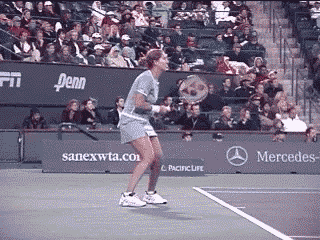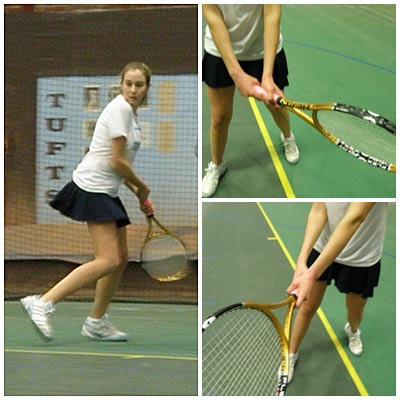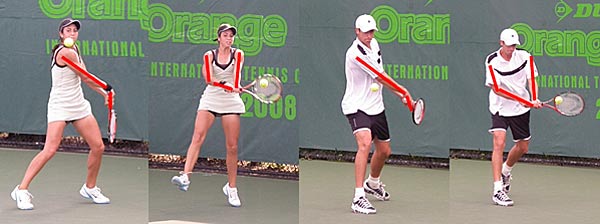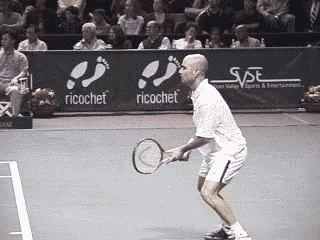|
TennisOne Lessons Two-Handed Backhand Styles Part 2 Doug Eng EdD, PhD In Part 1, we looked at the grips, hand dominance, and elbow positions for the two-handed backhand. We looked at different grips and how the elbows bent during the swing was dependent upon the grip used. For examples, we looked at some of the top junior players in the world. Using junior tennis players as our primary examples is a refreshing way to look at the subject and represents tennis in the near future. In Part 2, we will look at the backswings, overall trends, and tactics. Backswing Styles
As we have last discussed, the grip influences hand dominance and elbow positioning. How you grip your racquet also affects your backswing. When the racquet is taken back, pressure can be applied equally by both hands if the right hand is set in a continental grip. If the right hand is in an eastern backhand grip, the wrists are fairly rigid. Your dominant arm tends to control the swing. Players with the eastern backhand grip tend to hold the racquet slightly higher due to the limited freedom of the wrist. In addition, the dominant arm and elbow tend to be fairly straight. The off arm provides some light support and the elbow is often more bent. Due to the relatively straight dominant arm, the backswing radius is farther away from the body. This grip is not used frequently by advanced players since it limits the power the left hand can supply. It also limits the versatility on a one-handed slice or drop shot. If you use an Australian forehand grip with your dominant hand, the dominant wrist can flex more. When the dominant wrist breaks, it is not in a position of strength and instead the off hand provides greater support. Relaxed breaking of the wrist also allows a lower backswing as shown in Figure 1 below.
Potentially, the lower backswing can lead to a natural topspin drive. In addition, wrist flexion increases the separation distance between the elbows. You might see some players with two bent elbows that stick out. Bent elbows tend to be closer to the body than straight elbows. So with an Australian forehand, often the racquet path in the backswing will be closer to the body. Look back at Monica Seles at the beginning of this article to see a superb example of the low backswing and double bent elbows. Our college player, Meghan, in Figure , uses a similar motion. In Figure 1, you can see that the off hand accelerates ahead of the dominant hand. In part 1, I mentioned the relatively straight elbows of Figure 2 and the bent elbows in Figure 5 at contact. This action occurs as the off hand accelerates the racquet head. Try it. You will find that to accelerate your off hand ahead, bending the dominant elbow downwards into the body on contact actually helps. In Figure 7, we see McHale and Domijan drop the racquet in the backswing with straight dominant elbows but bent wrists. As they swing forward and up, they bend the dominant elbow into the body as the off arm accelerates forward.
If the hand is in a pure continental grip, either hand may control the swing. You may see a good amount of variety with the backswings. It seems that many top juniors today will initially take their backswings high as shown in Figure 3. We see less and less of the low backswing that might have occurred in the 1970s or 1980s. Today’s players are taught to play the power game where the high backswing of the forehand and backhand increase potential energy and lengthen the swing loop. Still the high backswings in Figure 3 are not as high as forehand backswings with the exception of McHale. So the loop on the backhand usually tends to be smaller than that on the forehand. If the dominant hand controls the swing, the wrist will tend to be fairly rigid and the dominant elbow tends to be straight as demonstrated by Yang. If the off hand controls the swing, the wrist may break and the elbow may bend easily to allow the off hand to accelerate the racquet as demonstrated by McHale. Although only five juniors are shown in Figure 3, you can see why some top coaches argue that males tend to use straighter arms than females.
The Future? In the tennis world, if you look at players over forty, you’ll find a good half will use one-handed backhands but most players under thirty years old will use a two-hander. Obviously, what the younger kids are doing often dictates the future. Almost all children under 14 years old will use a two-hander and if they switch to a one-hander, it is often between the ages of 10 and 16 years old. So a good gauge is to look at some of the best up-and-coming teenagers to see what might happen in the next ten to fifteen years.
I think we are seeing more top juniors coming up with higher backswings and loops. In contrast to Monica Seles low preparation, juniors use backswing preparation more similarly to Andre Agassi. However, Andre uses relatively straight arms and more dominant arm than the off arm. Christina McHale, the 16-year old who qualified for the Australian Open (and cramped in an early round match but courageously pulled out the match) has a significant loop backswing. It will be interesting to see if she shortens her loop as she faces bigger hitters on the WTA Tour. She will have less time to swing. The loop backswing can be a result of either trying to swing the racquet with the off hand similar to a forehand. Or it can simple be the result of dominant hand tension. As the dominant hand tightens, the racquet points up in the initial shoulder turn. Perhaps a great backhand swing on the tour that is most like the upcoming juniors belongs to David Nalbandian. In addition, top juniors seem to be using the Continental or Australian forehand grip with the off hand almost exclusively providing equal or greater control and power in the swing. In a sense, with the high backswing, the two-hander usually resembles the forehand. Tactics Andre Agassi has commented that he feels the continental grip with the dominant hand controlling the swing is the most ideal. This grip style will give you the most versatility. You can hit good topspin drives; you can let go and hit the one-handed slice or drop shot. You can volley with either one or two hands. If the dominant hand is in the eastern backhand grip, the topspin drive is effective; however, it is more difficult to get low balls since the racquet face won’t open as easily. Impact slice for defensive plays and drop shots are also more difficult. High volleys are easy to attack since the racquet face is naturally more closed but low volleys may be difficult and a switch to a continental grip is more desirable.
If the dominant hand is in a forehand grip, the off hand does most of the work. Defensive play and slicing is more difficult unless you play an off-handed forehand. If you slide the dominant hand to an Australian backhand grip, it will lend more support and it is easier to drop shot or play low volleys. This grip style, however, has a great advantage in letting the off-hand overtake the dominant hand and accelerate the racquet. If the off-hand is strong enough, it can give rise to a whippy stroke that is hard to read. You can produce terrific crosscourt angles and change directions relatively late in the swing. Conclusion To summarize:
Even if you follow these points, keep in mind, there is a good amount of variety in backhand styles. Play around with your backhand starting with the grip. When asked what kept him going strong in his last few years on the tour, Andre Agassi replied every day in practice he believed he could get better. So be like Andre and don't be afraid to test drive and improve your backhand. You just might get better! Your comments are welcome. Let us know what you think about Doug Eng's article by emailing us here at TennisOne.
Doug Eng EdD PhD coaches men's tennis at Tufts University. During the summer, he directs at the Tennis Camps at Harvard. He has received divisional Pro of the Year honors from the PTR and USPTA and several national award. Doug completed the USTA High Performance Coaches program and frequently runs educational and training programs for coaches. Doug also writes and speaks on tennis and sport science. |






